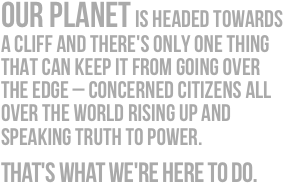-by Moisés Flores Baca
Today is the Youth and Future Generations day and the YOUNGO, or Youth Constituency, is organizing a big series of various events to make the youth’s voices be heard. One of these events will be the “Market of our Futures” at which the different NGO’s that form the constituency will present different items for sale that symbolize the fact that our future is being sold through carbon markets and other flexibility mechanisms. The event will be running from 1 to 3, when the break for the plenaries takes place and the majority of the negotiators will be having lunch at the Cancunmesse (the facilities where side-events are taking place). It will consist of the different NGOs symbolically selling things such as “endangered species” or “glaciers”. Since the COA delegation did not want to be left behind on such an important day we decided to put up a “shop” too: we will be selling ocean pH, thus representing the ongoing acidification of the world’s seas due to elevated levels of carbon in the atmosphere. This acidification puts at stake not only the lives of corals and other marine specimens, but also the survival of many fishing communities around the world.
To carry this action out we will have fake litmus papers (those used to measure pH) and hand them out, each of them representing a tenth of a unit of pH. As decorations for our booth we have prepared a banner with the legend “Ocean Decay” using a design similar to that of the juice brand “Ocean Spray”; also a pH scale that shows the ocean pH at pre-Industrial Revolution levels (8.19), the levels predicted for the end of the century (7.78!), and the levels at which all fish would be dead (4.2). To cause more of a visual impact we show a happy cartoonish whale on the basic side and a realistic whale skull (of course we had to have COA there somehow) with a big cross on its styrofoam eye and the legend “… and the whales too” complementing the “All fish dead” on the 4.2 of the scale.
Without the ocean playing the role of “carbon sink” that it has so far has the concentration of carbon dioxide in the atmosphere would have been 55% higher than what it has been in the last 250 years. Continuously increasing emissions of green house gases put further pressure in an ocean that is already incapable of absorbing the 2.15 billion metric tons of CO2 it releases every year, capacity that it had previous to the Industrial Revolution. To reach, if not exactly this level of equilibrium, at least a close-enough level we have to substantially decrease not only the release of CO2 emissions, but the CO2 that is already in the atmosphere.
Stay tuned to our blog for an update on how the whole event turns out.


